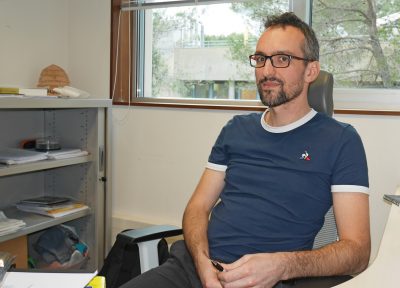Portrait of Aurélien Larcher
Assistant research professor in CFL team

Aurelien Larcher joined the CFL team in December 2018 as a research fellow in computer science. Aurelien settles down at CEMEF after a long journey abroad.
In this interview, Aurélien Larcher tells us about his career and his new research projects. He also explains what he loves in his new position.
WHAT'S YOUR FOUR-DATE ITINERARY?
2010: I'm defending my PhD thesis at IRSN on numerical methods for turbulence, with reactor accidents as an application.
2011: I'm then leaving for Stockholm for a postdoc at the Royal Institute of Technology (KTH). I will stay there for 4 years and do my research on high-performance computing to simulate turbulent flows for aeronautical applications.
2015: I join the mathematics department of NTNU in Trondheim where I obtained a research scholarship. I work on numerical schemes in turbulence.
2017: I become Director of Research of the start-up created from our research work at KTH and I am in parallel on a half position of Lecturer at the NTNU.
WHY APPLY TO CEMEF?
For me, there is a real challenge in which I visualize myself well. Indeed, I am asked to carry out a very upstream numerical research with the aim of making an application that can be used by industrialists. At CEMEF, these two aspects are reconciled. And that is what I had been missing until now. It was either very theoretical or very applied. It was difficult for me to find an environment in which I felt totally comfortable. I couldn't see myself studying the same sharp subject for 10 years or making very nice pictures - in digital it's very easy to get nice simulations - without being interested in their physical validity.
I really like the motto "Theory and Practice" of MINES ParisTech, it suits me very well.
WHAT IS THE SUBJECT OF YOUR WORK?
I work on all aspects of numerical methods development, in fluid mechanics but also on fluid/structure interaction. I combine applied mathematics, parallel computing and physical modelling. For this last point, I am not a specialist but I can understand it and adjust it. The overall question is this one: How to simulate the evolution of interfaces in general whether they are between two fluids or between a fluid and a solid?
I like the virtuous circle of partnership research. It's a challenge every time. You have to look for both scientific and technological solutions. If the model doesn't exist, we have to develop it. If there is an existing one, we have to adapt it, increment it, improve the implementation... They mutually serve research and science. Scientific increments bring new possibilities for new applications. And technology increments give us resources for new model developments.
A MILESTONE SINCE YOUR ARRIVAL
The creation of the doctoral speciality "Numerical Mathematics, Intensive Computing and Data" at the start of the 2019 academic year.
I am in charge of 1st year PhD students. The transmission aspect is important. And here too, there is the combination of theory and practice with courses that cover all the spectrums and which give good advanced theoretical bases and concrete projects to apply them. It's a good way to pass on the baton. In this way, students are trained to be very comfortable with simulation tools and to be able to innovate in the field.
CEMEF IN THREE WORDS
1. Multidisciplinarity that I love: researchers interact a lot, no one is stuck in his/her own backyard. We exchange, discuss and make progress together.
2. Projects challenge
3. Scientific emulation
I found a scientific environment in which I feel real good.
I really like the motto "Theory and Practice" of MINES ParisTech, it suits me very well.


